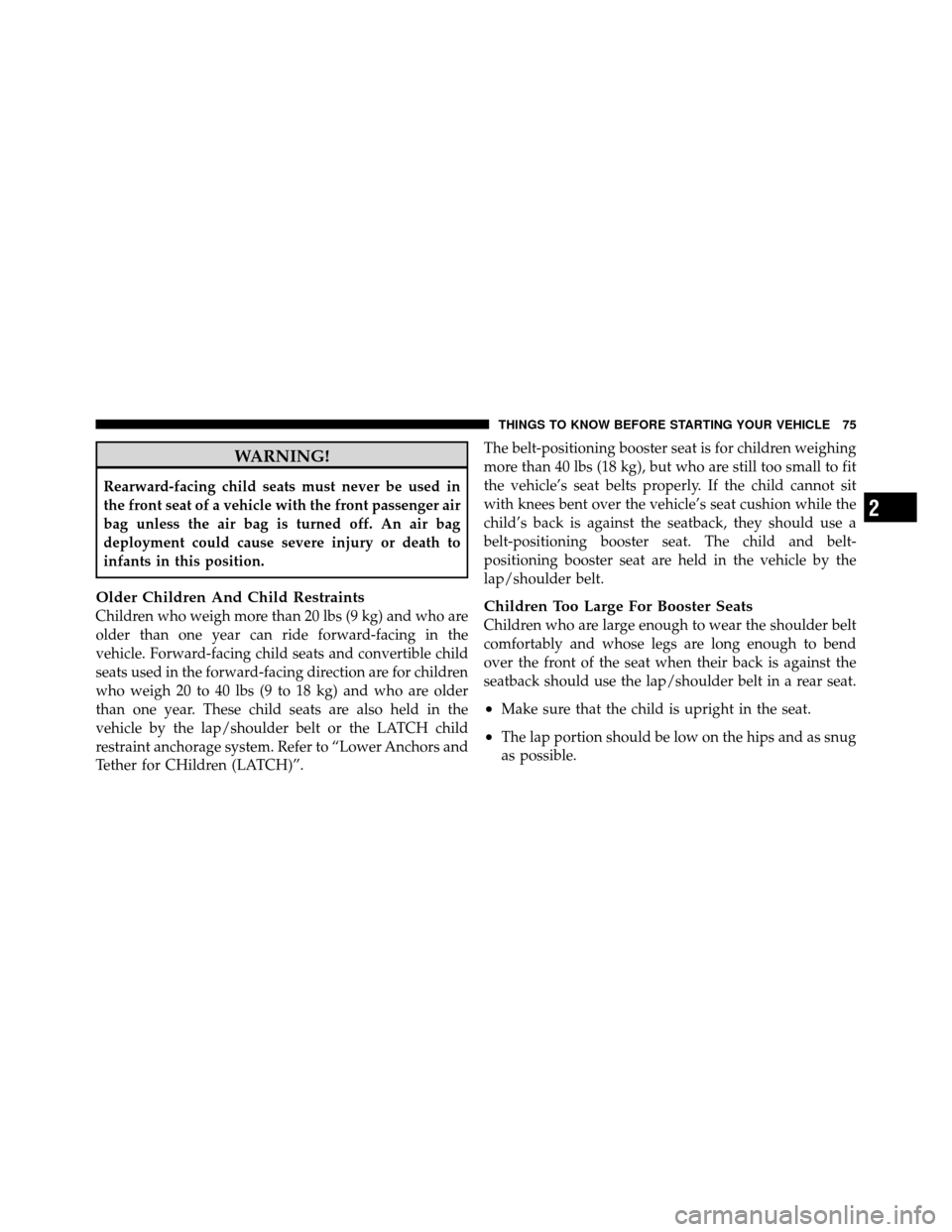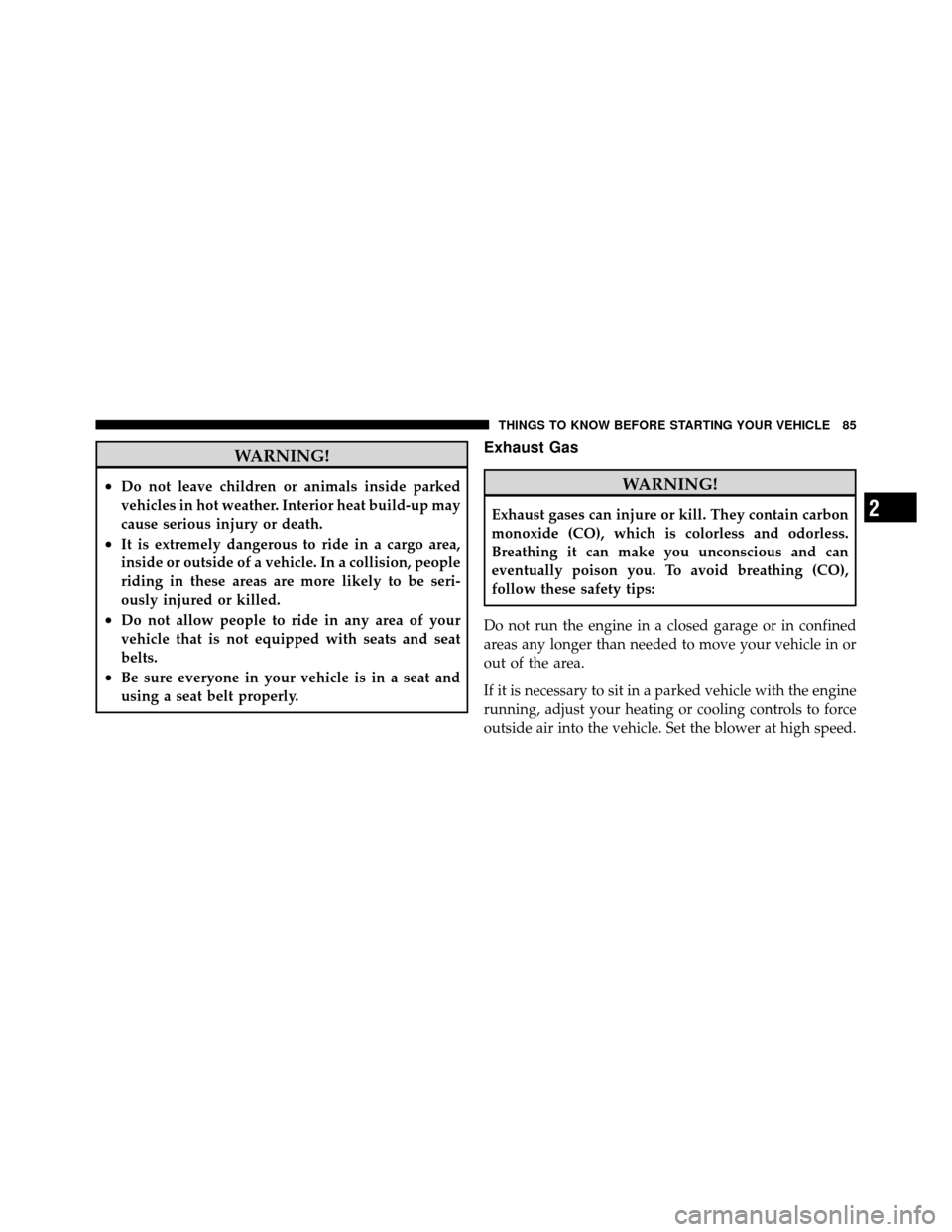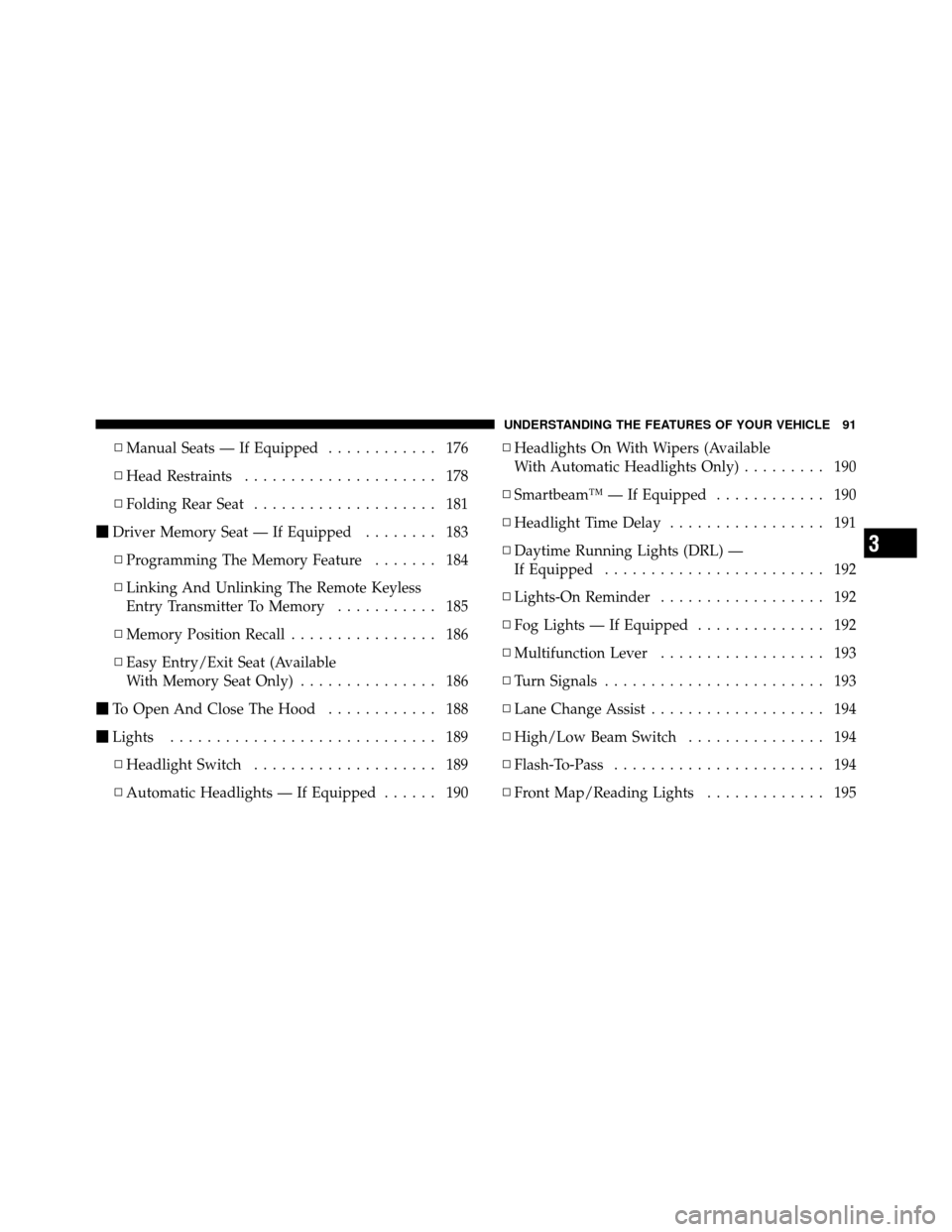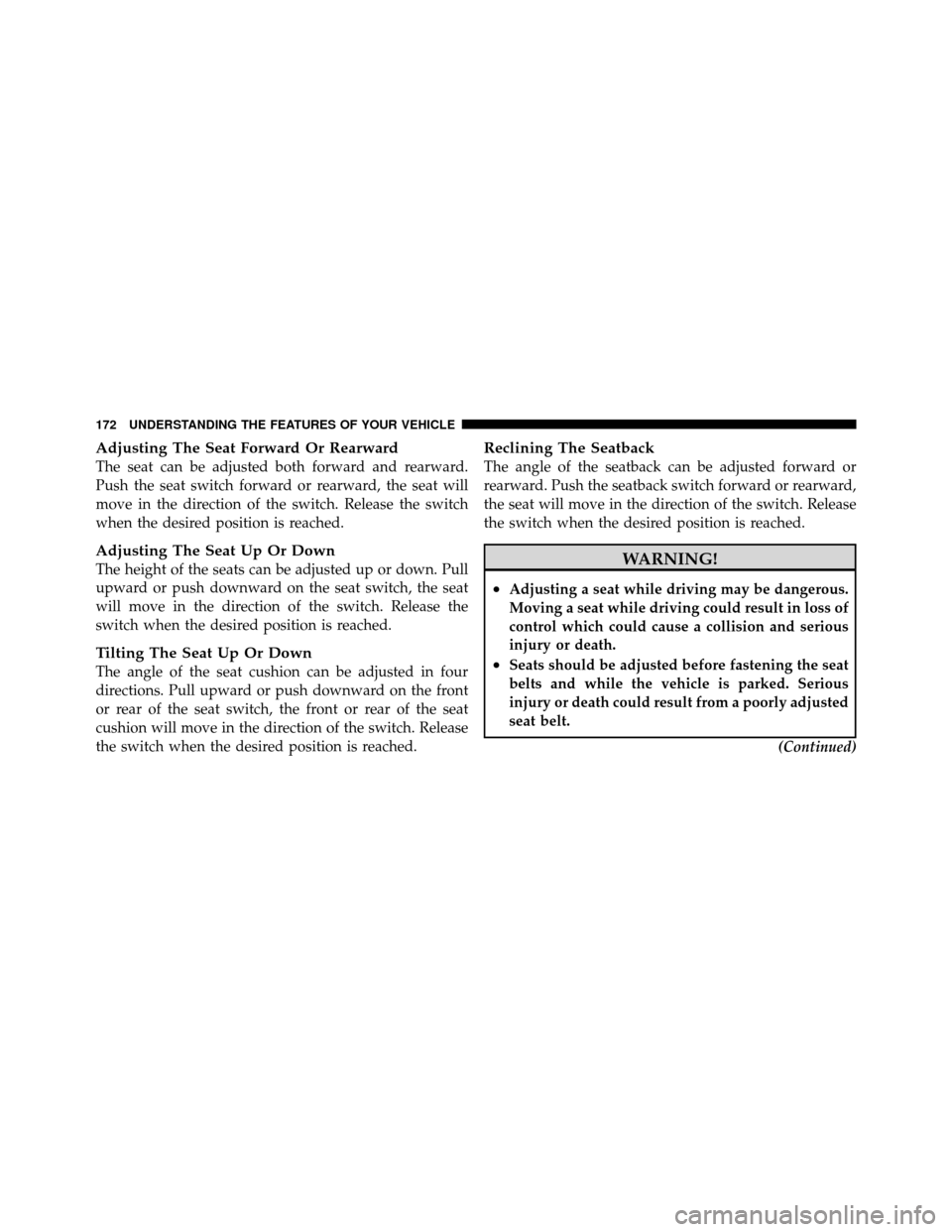Page 76 of 566

WARNING!
In a collision, an unrestrained child, even a tiny baby,
can become a projectile inside the vehicle. The force
required to hold even an infant on your lap could
become so great that you could not hold the child, no
matter how strong you are. The child and others
could be badly injured. Any child riding in your
vehicle should be in a proper restraint for the child’s
size.
There are different sizes and types of restraints for
children from newborn size to the child almost large
enough for an adult safety belt. Always check the child
seat Owner’s Manual to ensure you have the correct seat
for your child. Use the restraint that is correct for your
child.
Infants And Child Restraints
•
Safety experts recommend that children ride
rearward-facing in the vehicle until they are at least
one year old and weigh at least 20 lbs (9 kg). Two types
of child restraints can be used rearward-facing: infant
carriers and convertible child seats.
•The infant carrier is only used rearward-facing in the
vehicle. It is recommended for children who weigh up
to about 20 lbs (9 kg). Convertible child seats can be
used either rearward-facing or forward-facing in the
vehicle. Convertible child seats often have a higher
weight limit in the rearward-facing direction than
infant carriers do, so they can be used rearward-facing
by children who weigh more than 20 lbs (9 kg) but are
less than one year old. Both types of child restraints are
held in the vehicle by the lap/shoulder belt or the
LATCH child restraint anchorage system. Refer to
“Lower Anchors and Tether for CHildren (LATCH)”.
74 THINGS TO KNOW BEFORE STARTING YOUR VEHICLE
Page 77 of 566

WARNING!
Rearward-facing child seats must never be used in
the front seat of a vehicle with the front passenger air
bag unless the air bag is turned off. An air bag
deployment could cause severe injury or death to
infants in this position.
Older Children And Child Restraints
Children who weigh more than 20 lbs (9 kg) and who are
older than one year can ride forward-facing in the
vehicle. Forward-facing child seats and convertible child
seats used in the forward-facing direction are for children
who weigh 20 to 40 lbs (9 to 18 kg) and who are older
than one year. These child seats are also held in the
vehicle by the lap/shoulder belt or the LATCH child
restraint anchorage system. Refer to “Lower Anchors and
Tether for CHildren (LATCH)”.The belt-positioning booster seat is for children weighing
more than 40 lbs (18 kg), but who are still too small to fit
the vehicle’s seat belts properly. If the child cannot sit
with knees bent over the vehicle’s seat cushion while the
child’s back is against the seatback, they should use a
belt-positioning booster seat. The child and belt-
positioning booster seat are held in the vehicle by the
lap/shoulder belt.Children Too Large For Booster Seats
Children who are large enough to wear the shoulder belt
comfortably and whose legs are long enough to bend
over the front of the seat when their back is against the
seatback should use the lap/shoulder belt in a rear seat.
•Make sure that the child is upright in the seat.
•The lap portion should be low on the hips and as snug
as possible.
2
THINGS TO KNOW BEFORE STARTING YOUR VEHICLE 75
Page 80 of 566
kits or retrofit kits. You are urged to take advantage of all
the available attachments provided with your child re-
straint in any vehicle.
All three rear-seating positions have lower anchorages
that are capable of accommodating LATCH-compatible
child seats. You should never install LATCH-compatible
child seats so that two seats share a common lower
anchorage. If installing child seats in adjacent rear-
seating positions, or if your child restraints are not
LATCH-compatible, install the restraints using the vehi-
cle’s seat belts.
Installing The LATCH-Compatible Child Restraint
System
We urge you to follow the manufacturer’s directions
carefully when installing your child restraint. Not all
child restraint systems will be installed as described here.
LATCH Anchorages
78 THINGS TO KNOW BEFORE STARTING YOUR VEHICLE
Page 87 of 566

WARNING!
•Do not leave children or animals inside parked
vehicles in hot weather. Interior heat build-up may
cause serious injury or death.
•It is extremely dangerous to ride in a cargo area,
inside or outside of a vehicle. In a collision, people
riding in these areas are more likely to be seri-
ously injured or killed.
•Do not allow people to ride in any area of your
vehicle that is not equipped with seats and seat
belts.
•Be sure everyone in your vehicle is in a seat and
using a seat belt properly.
Exhaust Gas
WARNING!
Exhaust gases can injure or kill. They contain carbon
monoxide (CO), which is colorless and odorless.
Breathing it can make you unconscious and can
eventually poison you. To avoid breathing (CO),
follow these safety tips:
Do not run the engine in a closed garage or in confined
areas any longer than needed to move your vehicle in or
out of the area.
If it is necessary to sit in a parked vehicle with the engine
running, adjust your heating or cooling controls to force
outside air into the vehicle. Set the blower at high speed.2
THINGS TO KNOW BEFORE STARTING YOUR VEHICLE 85
Page 92 of 566

�Uconnect™ Phone ..................... 109
▫ Uconnect Touch™ 4.3 ................. 109
▫ Operation ......................... 112
▫ Phone Call Features .................. 118
▫ Uconnect™ Phone Features ............. 122
▫ Advanced Phone Connectivity ........... 127
▫ Things You Should Know About Your
Uconnect™ Phone .................... 127
▫ General Information .................. 131
� Uconnect™ Phone ..................... 131
▫ Uconnect Touch™ 8.4/8.4 NAV .......... 131
▫ Operation ......................... 134
▫ Phone Call Features .................. 145 ▫
Uconnect™ Phone Features ............. 150
▫ Advanced Phone Connectivity ........... 154
▫ Things You Should Know About Your
Uconnect™ Phone .................... 155
▫ General Information .................. 163
� Voice Command ...................... 163
▫ Uconnect Touch™ 8.4/8.4 NAV .......... 163
▫ Uconnect™ Voice Commands ........... 165
▫ Voice Tree ......................... 167
� Seats .............................. 171
▫ Power Seats — If Equipped ............. 171
▫ Power Lumbar — If Equipped ........... 173
▫ Heated Seats — If Equipped ............ 174
90 UNDERSTANDING THE FEATURES OF YOUR VEHICLE
Page 93 of 566

▫Manual Seats — If Equipped ............ 176
▫ Head Restraints ..................... 178
▫ Folding Rear Seat .................... 181
� Driver Memory Seat — If Equipped ........ 183
▫ Programming The Memory Feature ....... 184
▫ Linking And Unlinking The Remote Keyless
Entry Transmitter To Memory ........... 185
▫ Memory Position Recall ................ 186
▫ Easy Entry/Exit Seat (Available
With Memory Seat Only) ............... 186
� To Open And Close The Hood ............ 188
� Lights ............................. 189
▫ Headlight Switch .................... 189
▫ Automatic Headlights — If Equipped ...... 190▫
Headlights On With Wipers (Available
With Automatic Headlights Only) ......... 190
▫ Smartbeam™ — If Equipped ............ 190
▫ Headlight Time Delay ................. 191
▫ Daytime Running Lights (DRL) —
If Equipped ........................ 192
▫ Lights-On Reminder .................. 192
▫ Fog Lights — If Equipped .............. 192
▫ Multifunction Lever .................. 193
▫ Turn Signals ........................ 193
▫ Lane Change Assist ................... 194
▫ High/Low Beam Switch ............... 194
▫ Flash-To-Pass ....................... 194
▫ Front Map/Reading Lights ............. 195
3
UNDERSTANDING THE FEATURES OF YOUR VEHICLE 91
Page 173 of 566
SEATS
Seats are a part of the Occupant Restraint System of the
vehicle.
WARNING!
•It is dangerous to ride in a cargo area, inside or
outside of a vehicle. In a collision, people riding in
these areas are more likely to be seriously injured
or killed.
•Do not allow people to ride in any area of your
vehicle that is not equipped with seats and seat
belts. In a collision, people riding in these areas
are more likely to be seriously injured or killed.
•Be sure everyone in your vehicle is in a seat and
using a seat belt properly.
Power Seats — If Equipped
On models equipped with power seats, the switch is
located on the outboard side of the seat near the floor.Use this switch to move the driver’s seat up or down,
forward or rearward or to recline the seatback.
NOTE:
The passenger’s seat will move up or down,
forward or rearward.
Power Seat Switches
1 — Seat Control
2 — Seatback Control
3
UNDERSTANDING THE FEATURES OF YOUR VEHICLE 171
Page 174 of 566

Adjusting The Seat Forward Or Rearward
The seat can be adjusted both forward and rearward.
Push the seat switch forward or rearward, the seat will
move in the direction of the switch. Release the switch
when the desired position is reached.
Adjusting The Seat Up Or Down
The height of the seats can be adjusted up or down. Pull
upward or push downward on the seat switch, the seat
will move in the direction of the switch. Release the
switch when the desired position is reached.
Tilting The Seat Up Or Down
The angle of the seat cushion can be adjusted in four
directions. Pull upward or push downward on the front
or rear of the seat switch, the front or rear of the seat
cushion will move in the direction of the switch. Release
the switch when the desired position is reached.
Reclining The Seatback
The angle of the seatback can be adjusted forward or
rearward. Push the seatback switch forward or rearward,
the seat will move in the direction of the switch. Release
the switch when the desired position is reached.
WARNING!
•Adjusting a seat while driving may be dangerous.
Moving a seat while driving could result in loss of
control which could cause a collision and serious
injury or death.
•Seats should be adjusted before fastening the seat
belts and while the vehicle is parked. Serious
injury or death could result from a poorly adjusted
seat belt.(Continued)
172 UNDERSTANDING THE FEATURES OF YOUR VEHICLE